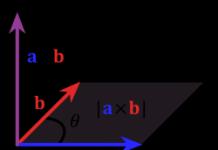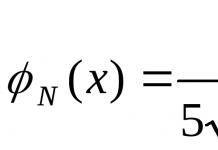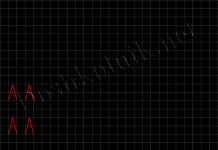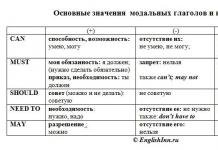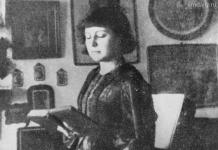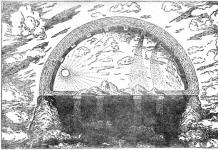Municipal budget educational institution
Savinskaya average comprehensive school
Parallelogram and its new properties
Completed by: 8B grade student
MBOU Savinskaya Secondary School
Kuznetsova Svetlana, 14 years old
Head: mathematics teacher
Tulchevskaya N.A.
p. Savino
Ivanovo region, Russia
2016
I. Introduction ___________________________________________________page 3
II. From the history of the parallelogram ___________________________________page 4
III Additional properties of a parallelogram ______________________________page 4
IV. Proof of properties _____________________________________ page 5
V. Solving problems using additional properties __________page 8
VI. Application of the properties of a parallelogram in life ___________________page 11
VII. Conclusion _________________________________________________page 12
VIII. Literature _________________________________________________page 13
Introduction
"Among equal minds
at equality of other conditions
he who knows geometry is superior"
(Blaise Pascal).
While studying the topic “Parallelogram” in geometry lessons, we looked at two properties of a parallelogram and three features, but when we started solving problems, it turned out that this was not enough.
I had a question: does a parallelogram have other properties, and how will they help in solving problems?
And I decided to study additional properties of a parallelogram and show how they can be applied to solve problems.
Subject of study : parallelogram
Object of study
: properties of a parallelogram
Goal of the work:
formulation and proof of additional properties of a parallelogram that are not studied at school;
application of these properties to solve problems.
Tasks:
Study the history of the appearance of the parallelogram and the history of the development of its properties;
Find further reading on the issue under study;
Study additional properties of a parallelogram and prove them;
Show the application of these properties to solve problems;
Consider the application of the properties of a parallelogram in life.
Research methods:
Working with educational and popular science literature, Internet resources;
Study of theoretical material;
Identification of a range of problems that can be solved using additional properties of a parallelogram;
Observation, comparison, analysis, analogy.
Duration of the study : 3 months: January-March 2016
From the history of the parallelogram
In a geometry textbook we read the following definition of a parallelogram: A parallelogram is a quadrilateral whose opposite sides are parallel in pairs.
The word "parallelogram" is translated as "parallel lines" (from Greek words Parallelos - parallel and gramme - line), this term was introduced by Euclid. In his book Elements, Euclid proved the following properties of a parallelogram: opposite sides and angles of a parallelogram are equal, and the diagonal bisects it. Euclid does not mention the point of intersection of a parallelogram. Only towards the end of the Middle Ages was a complete theory of parallelograms developed. And only in the 17th century did theorems about parallelograms appear in textbooks, which are proven using Euclid’s theorem on the properties of a parallelogram.
III Additional properties of a parallelogram
In the geometry textbook, only 2 properties of a parallelogram are given:
Opposite angles and sides are equal
The diagonals of a parallelogram intersect and are bisected by the intersection point.
In various sources on geometry you can find the following additional properties:
The sum of adjacent angles of a parallelogram is 180 0
The bisector of the angle of a parallelogram cuts off from it isosceles triangle;
The bisectors of opposite angles of a parallelogram lie on parallel lines;
The bisectors of adjacent angles of a parallelogram intersect at right angles;
When the bisectors of all angles of a parallelogram intersect, they form a rectangle;
The distances from opposite corners of a parallelogram to the same diagonal are equal.
If in a parallelogram we connect opposite vertices with their midpoints opposite sides, then you get another parallelogram.
The sum of the squares of the diagonals of a parallelogram is equal to twice the sum of the squares of its adjacent sides.
If you draw altitudes from two opposite angles in a parallelogram, you get a rectangle.
IV Proof of the properties of a parallelogram
The sum of adjacent angles of a parallelogram is 180 0
Given:
ABCD – parallelogram
Prove:
 A+
A+  B=
B= 
Proof:
 A and
A and  B – internal one-sided angles with parallel lines BC
B – internal one-sided angles with parallel lines BC  AD and secant AB, which means
AD and secant AB, which means  A+
A+  B=
B= 
2
Given: ABCD - parallelogram,
AK bisector  A.
A.
Prove:  AVK – isosceles
AVK – isosceles
Proof:
1)  1=
1= 3 (crosswise lying at BC
3 (crosswise lying at BC  AD and secant AK ),
AD and secant AK ),
2)  2=
2= 3 because AK is a bisector,
3 because AK is a bisector,
means 1=  2.
2.
3)  ABC - isosceles because 2 angles of a triangle are equal
ABC - isosceles because 2 angles of a triangle are equal

3
Given: ABCD is a parallelogram,
AK – bisector A,
CP - bisector C.
Prove: AK ║ SR
Proof:
1) 1=2 because AK is a bisector
2) 4=5 because CP – bisector
3) 3=1 (crosswise lying angles at
BC ║ AD and AK-secant),
4) A =C (by the property of a parallelogram), which means 2=3=4=5.
4) From paragraphs 3 and 4 it follows that 1 = 4, and these angles are corresponding to straight lines AK and CP and secant BC,
this means AK ║ CP (based on the parallelism of lines)
. Bisectors of opposite angles of a parallelogram lie on parallel lines
Bisectors of adjacent angles of a parallelogram intersect at right angles

Given: ABCD - parallelogram,
AK-bisector A,
DP bisector D
Prove: DP  AK.
AK.
Proof:
1) 1=2, because AK - bisector
Let 1=2=x, then A=2x,
2) 3=4, because D Р – bisector
Let 3=4=y, then D=2y
3) A + D =180 0, because the sum of adjacent angles of a parallelogram is 180
2) Consider  A OD
A OD
1+3=90 0 , then  <5=90 0 (сумма углов треугольников равна 180 0)
<5=90 0 (сумма углов треугольников равна 180 0)
5. The bisectors of all angles of a parallelogram when intersecting form a rectangle

Given: ABCD - parallelogram, AK-bisector A,
DP-bisector D,
CM bisector C,
BF - bisector B .
Prove: KRNS - rectangle
Proof:
Based on the previous property 8=7=6=5=90 0 ,
means KRNS is a rectangle.
The distances from opposite corners of a parallelogram to the same diagonal are equal.

Given: ABCD-parallelogram, AC-diagonal.
VC  AC, D.P.
AC, D.P.  A.C.
A.C.
Prove: BC=DP
Proof: 1) DCP = KAB, as internal crosses lying with AB ║ CD and secant AC.
2)  AKB=
AKB=  CDР (along the side and two adjacent angles AB=CD CD P=AB K).
CDР (along the side and two adjacent angles AB=CD CD P=AB K).
And in equal triangles the corresponding sides are equal, which means DP=BK.
If you connect opposite vertices in a parallelogram with the midpoints of opposite sides, you get another parallelogram.
Given: ABCD parallelogram.
Prove: VKDR is a parallelogram.
Proof:
1) BP=KD (AD=BC, points K and P
divide these sides in half)
2) BP ║ KD (lie on AD  BC)
BC)
If the opposite sides of a quadrilateral are equal and parallel, then the quadrilateral is a parallelogram.

If you draw altitudes from two opposite angles in a parallelogram, you get a rectangle.

The sum of the squares of the diagonals of a parallelogram is equal to twice the sum of the squares of its adjacent sides.
Given: ABCD is a parallelogram. BD and AC are diagonals.
Prove: AC 2 +ВD 2 =2(AB 2 + AD 2 )
Proof: 1) ASK:
A.C.
²=
ASK:
A.C.
²=
 +
+

2)B RD : BD 2 = B R 2 + RD 2 (according to the Pythagorean theorem)
3) A.C. ²+ BD ²=SK²+A K²+B Р²+РD ²
4) SC = BP = N(height )
5) AC 2 +BD 2 = H 2 + A TO 2 + H 2 +PD 2
6)
Let
D
K=A
P=x, Then  C
TOD
:
H
2
=
CD
2
- X 2
according to the Pythagorean theorem )
C
TOD
:
H
2
=
CD
2
- X 2
according to the Pythagorean theorem )
7) AC²+BD ² = CD 2 - x²+ AK 1 ²+ CD 2 -X 2 +PD 2 ,
AC²+BD ²=2СD 2 -2x 2 + A TO 2 +PD 2
8) A TO=AD+ X, RD=AD- X,
AC²+BD ² =2CD 2 -2x 2 +(AD +x) 2 +(AD -X) 2 ,
AC²+
IND²=2
WITHD²-2
X² +AD
2
+2AD
X+
X 2
+AD
2
-2AD
X+
X 2
,
AC²+
IND²=2CD
2
+2AD
2
=2(CD
2
+AD
2
).

V . Solving problems using these properties
The point of intersection of the bisectors of two angles of a parallelogram adjacent to one side belongs to the opposite side. The shortest side of a parallelogram is 5 . Find its larger side.
Given: ABCD is a parallelogram,
AK – bisector  A,
A,
D K – bisector  D , AB=5
D , AB=5
Find: Sun
 decision
decision Solution
Because AK - bisector  And then ABC is isosceles.
And then ABC is isosceles.
Because D K – bisector  D, then
D, then  DCK - isosceles
DCK - isosceles
DC =C K= 5
Then, BC=VC+SC=5+5 = 10
Answer: 10
2. Find the perimeter of a parallelogram if the bisector of one of its angles divides the side of the parallelogram into segments of 7 cm and 14 cm.

1 case
Given:  A,
A,
VK=14 cm, KS=7 cm
Find: P parallelogram
Solution
VS=VK+KS=14+7=21 (cm)
Because AK – bisector  And then ABC is isosceles.
And then ABC is isosceles.
AB=BK= 14 cm
 Then P=2 (14+21) =70 (cm)
Then P=2 (14+21) =70 (cm)
Given: ABCD is a parallelogram,
D K – bisector  D
D
VK=14 cm, KS=7 cm
Find: P parallelogram
Solution
VS=VK+KS=14+7=21 (cm)
Because D K – bisector  D, then
D, then  DCK - isosceles
DCK - isosceles
DC =C K= 7
Then, P = 2 (21+7) = 56 (cm)
Answer: 70cm or 56cm
3. The sides of a parallelogram are 10 cm and 3 cm. The bisectors of two angles adjacent to the larger side divide the opposite side into three segments. Find these segments.
1 case: bisectors intersect outside the parallelogram

Given: ABCD – parallelogram, AK – bisector  A,
A,
D K – bisector  D , AB=3 cm, BC=10 cm
D , AB=3 cm, BC=10 cm
Find: VM, MN, NC
Solution
Because AM - bisector  And then AVM is isosceles.
And then AVM is isosceles.
Because DN – bisector  D, then
D, then  DCN - isosceles
DCN - isosceles
DC=CN=3
Then, MN = 10 – (BM +NC) = 10 – (3+3)=4 cm
Case 2: bisectors intersect inside a parallelogram

Because AN - bisector  And then ABN is isosceles.
And then ABN is isosceles.
AB=BN = 3 D
And the sliding grille should be moved to the required distance in the doorway
Parallelogram mechanism- a four-bar mechanism, the links of which form a parallelogram. It is used to implement translational motion by hinged mechanisms.
Parallelogram with a fixed link- one link is motionless, the opposite one makes a rocking motion, remaining parallel to the motionless one. Two parallelograms connected one behind the other give the end link two degrees of freedom, leaving it parallel to the stationary link.
Examples: bus windshield wipers, forklifts, tripods, hangers, car suspensions.
Parallelogram with fixed joint- the property of a parallelogram to maintain a constant ratio of distances between three points is used. Example: drawing pantograph - a device for scaling drawings.
Rhombus- all links are the same length, the approach (contraction) of a pair of opposite hinges leads to the moving apart of the other two hinges. All links work in compression.
Examples - automobile diamond-shaped jack, tram pantograph.
Scissor or X-shaped mechanism, also known as Nuremberg scissors- rhombus version - two links connected in the middle by a hinge. The advantages of the mechanism are compactness and simplicity, the disadvantage is the presence of two sliding pairs. Two (or more) such mechanisms connected in series form a diamond(s) in the middle. Used in lifts and children's toys.
VII Conclusion
Who has been studying mathematics since childhood?
he develops attention, trains his brain,
own will, cultivates perseverance
and perseverance in achieving goals
A. Markushevich
During the work, I proved additional properties of the parallelogram.
I was convinced that by using these properties, you can solve problems faster.
I showed how these properties are applied using examples of solving specific problems.
I learned a lot about the parallelogram, which is not in our geometry textbook
I was convinced that knowledge of geometry is very important in life through examples of the application of the properties of a parallelogram.
The purpose of my research work has been completed.
The importance of mathematical knowledge is evidenced by the fact that a prize was established for the person who publishes a book about a person who lived his entire life without the help of mathematics. Not a single person has received this award yet.
VIII Literature
Pogorelov A.V. Geometry 7-9: textbook for general education. institutions - M.: Education, 2014
L.S.Atanasyan and others. Geometry. Add. Chapters for the 8th grade textbook: textbook. manual for students of schools and advanced classes. studied mathematics. – M.: Vita-press, 2003
Internet resources
Wikipedia materials
A parallelogram is a quadrilateral whose opposite sides are parallel in pairs. The following figure shows parallelogram ABCD. It has side AB parallel to side CD and side BC parallel to side AD.
As you may have guessed, a parallelogram is a convex quadrilateral. Let's consider the basic properties of a parallelogram.
Properties of a parallelogram
1. In a parallelogram, opposite angles and opposite sides are equal. Let's prove this property - consider the parallelogram presented in the following figure.

Diagonal BD divides it into two equal triangles: ABD and CBD. They are equal along the side BD and the two angles adjacent to it, since the angles lying crosswise at the secant BD of parallel lines BC and AD and AB and CD, respectively. Therefore AB = CD and
BC = AD. And from the equality of angles 1, 2, 3 and 4 it follows that angle A = angle1 + angle3 = angle2 + angle4 = angle C.
2. The diagonals of a parallelogram are divided in half by the point of intersection. Let point O be the intersection point of diagonals AC and BD of parallelogram ABCD.
Then triangle AOB and triangle COD are equal to each other, along the side and two adjacent angles. (AB = CD since these are opposite sides of the parallelogram. And angle1 = angle2 and angle3 = angle4 are like crosswise angles when the lines AB and CD intersect with the secants AC and BD, respectively.) From this it follows that AO = OC and OB = OD, which and needed to be proven.

All main properties are illustrated in the following three figures.
Sign-ki pa-ral-le-lo-gram-ma
1. Definition and basic properties of a parallelogram
Let's start by recalling the definition of para-ral-le-lo-gram.
Definition. Parallelogram- what-you-re-gon-nick, which has every two pro-ti-false sides that are parallel (see Fig. . 1).

Rice. 1. Pa-ral-le-lo-gram
Let's remember basic properties of pa-ral-le-lo-gram-ma:
In order to be able to use all these properties, you need to be sure that the fi-gu-ra, about someone -roy we are talking about, - par-ral-le-lo-gram. To do this, it is necessary to know such facts as signs of pa-ral-le-lo-gram-ma. We are looking at the first two of them now.
2. The first sign of a parallelogram
Theorem. The first sign of pa-ral-le-lo-gram-ma. If in a four-coal the two opposite sides are equal and parallel, then this four-coal nickname - parallelogram. ![]() .
.

Rice. 2. The first sign of pa-ral-le-lo-gram-ma
Proof. Let's put the dia-go-nal in the four-reh-coal-ni-ka (see Fig. 2), she split it into two tri-coal-ni-ka. Let's write down what we know about these triangles:
according to the first sign of the equality of triangles.
From the equality of the indicated triangles it follows that, by the sign of the parallelism of straight lines when crossing, ch-nii their s-ku-shchi. We have that:
![]()
Do-ka-za-but.
3. Second sign of a parallelogram
Theorem. The second sign is pa-ral-le-lo-gram-ma. If in a four-corner every two pro-ti-false sides are equal, then this four-corner is parallelogram. ![]() .
.

Rice. 3. The second sign of pa-ral-le-lo-gram-ma
Proof. We put the dia-go-nal into the four-corner (see Fig. 3), she splits it into two triangles. Let's write down what we know about these triangles, based on the theory's form:
 according to the third sign of the equality of triangles.
according to the third sign of the equality of triangles.
From the equality of triangles it follows that, by the sign of parallel lines, when intersecting them s-ku-shchey. Let's eat:
![]() par-ral-le-lo-gram by definition. Q.E.D.
par-ral-le-lo-gram by definition. Q.E.D.
Do-ka-za-but.
4. An example of using the first parallelogram feature
Let's look at an example of the use of signs of pa-ral-le-lo-gram.
Example 1. In the bulge there are no coals Find: a) the corners of the coals; b) hundred-ro-well.
Solution. Illustration Fig. 4.

![]() pa-ral-le-lo-gram according to the first sign of pa-ral-le-lo-gram-ma.
pa-ral-le-lo-gram according to the first sign of pa-ral-le-lo-gram-ma.
A. ![]() by the property of a par-ral-le-lo-gram about pro-ti-false angles, by the property of a par-ral-le-lo-gram about the sum of angles, when lying to one side.
by the property of a par-ral-le-lo-gram about pro-ti-false angles, by the property of a par-ral-le-lo-gram about the sum of angles, when lying to one side.
B. ![]() by the nature of equality of pro-false sides.
by the nature of equality of pro-false sides.
re-tiy sign pa-ral-le-lo-gram-ma
5. Review: Definition and Properties of a Parallelogram
Let's remember that parallelogram- this is a four-square-corner, which has pro-ti-false sides in pairs. That is, if - par-ral-le-lo-gram, then ![]() (see Fig. 1).
(see Fig. 1).

The parallel-le-lo-gram has a number of properties: the opposite angles are equal (), the opposite angles -we are equal ( ![]() ). In addition, the dia-go-na-li pa-ral-le-lo-gram-ma at the point of re-se-che-niya is divided according to the sum of the angles, at-le- pressing towards any side pa-ral-le-lo-gram-ma, equal, etc.
). In addition, the dia-go-na-li pa-ral-le-lo-gram-ma at the point of re-se-che-niya is divided according to the sum of the angles, at-le- pressing towards any side pa-ral-le-lo-gram-ma, equal, etc.
But in order to take advantage of all these properties, it is necessary to be absolutely sure that the ri-va-e-my th-you-rekh-coal-nick - pa-ral-le-lo-gram. For this purpose, there are signs of par-ral-le-lo-gram: that is, those facts from which one can draw a single-valued conclusion , that what-you-rekh-coal-nick is a par-ral-le-lo-gram-mom. In the previous lesson, we already looked at two signs. Now we're looking at the third time.
6. The third sign of a parallelogram and its proof
If in a four-coal there is a dia-go-on at the point of re-se-che-niya they do-by-lams, then the given four-you Roh-coal-nick is a pa-ral-le-lo-gram-mom.
Given:
What-you-re-coal-nick; ; .
Prove:
Parallelogram.
Proof:
In order to prove this fact, it is necessary to show the parallelism of the parties to the par-le-lo-gram. And the parallelism of straight lines is most often achieved through the equality of internal cross-lying angles at these right angles. Thus, here is the next method to obtain the third sign of par-ral -le-lo-gram-ma: through the equality of triangles ![]() .
.
Let's see how these triangles are equal. Indeed, from the condition it follows: . In addition, since the angles are vertical, they are equal. That is:
 (first sign of equalitytri-coal-ni-cov- along two sides and the corner between them).
(first sign of equalitytri-coal-ni-cov- along two sides and the corner between them).
From the equality of triangles: (since the internal cross-lying angles at these straight lines and cross-sections are equal). In addition, from the equality of triangles it follows that . This means that we understand that in four-coal two hundred are equal and parallel. According to the first sign, pa-ral-le-lo-gram-ma: - pa-ral-le-lo-gram.
Do-ka-za-but.
7. Example of a problem on the third sign of a parallelogram and generalization
Let's look at the example of using the third sign of pa-ral-le-lo-gram.
Example 1
Given:
- parallelogram; . - se-re-di-na, - se-re-di-na, - se-re-di-na, - se-re-di-na (see Fig. 2).

Prove:- pa-ral-le-lo-gram.
Proof:
![]()
![]()
This means that in the four-coal-no-dia-go-on-whether at the point of re-se-che-niya they do-by-lam. By the third sign of pa-ral-le-lo-gram, it follows from this that - pa-ral-le-lo-gram.
Do-ka-za-but.
If you analyze the third sign of pa-ral-le-lo-gram, then you can notice that this sign is with-vet- has the property of a par-ral-le-lo-gram. That is, the fact that the dia-go-na-li de-la-xia is not just a property of the par-le-lo-gram, and its distinctive, kha-rak-te-ri-sti-che-property, by which it can be distinguished from the set what-you-rekh-coal-ni-cov.
SOURCE
http://interneturok.ru/ru/school/geometry/8-klass/chyotyrehugolniki/priznaki-parallelogramma
http://interneturok.ru/ru/school/geometry/8-klass/chyotyrehugolniki/tretiy-priznak-parallelogramma
http://www.uchportfolio.ru/users_content/675f9820626f5bc0afb47b57890b466e/images/46TThxQ8j4Y.jpg
http://cs10002.vk.me/u31195134/116260458/x_56d40dd3.jpg
http://wwww.tepka.ru/geometriya/16.1.gif
Lesson topic
- Properties of the diagonals of a parallelogram.
Lesson Objectives
- Get acquainted with new definitions and remember some already studied.
- State and prove the property of the diagonals of a parallelogram.
- Learn to apply the properties of shapes when solving problems.
- Developmental – to develop students’ attention, perseverance, perseverance, logical thinking, mathematical speech.
- Educational - through the lesson, cultivate an attentive attitude towards each other, instill the ability to listen to comrades, mutual assistance, and independence.
Lesson Objectives
- Test students' problem-solving skills.
Lesson Plan
- Introduction.
- Repetition of previously studied material.
- Parallelogram, its properties and features.
- Examples of tasks.
- Self-check.
Introduction
“A major scientific discovery provides a solution to a major problem, but in the solution of any problem there is a grain of discovery.”

Property of opposite sides of a parallelogram
A parallelogram has opposite sides that are equal.
Proof.
Let ABCD be the given parallelogram. And let its diagonals intersect at point O.
Since Δ AOB = Δ COD by the first criterion of equality of triangles (∠ AOB = ∠ COD, as vertical ones, AO=OC, DO=OB, by the property of the diagonals of a parallelogram), then AB=CD. In the same way, from the equality of triangles BOC and DOA, it follows that BC = DA. The theorem has been proven.
Property of opposite angles of a parallelogram
In a parallelogram, opposite angles are equal.
Proof.
Let ABCD be the given parallelogram. And let its diagonals intersect at point O.
From what was proven in the theorem about the properties of the opposite sides of a parallelogram Δ ABC = Δ CDA on three sides (AB=CD, BC=DA from what was proven, AC – general). From the equality of triangles it follows that ∠ ABC = ∠ CDA.
It is also proved that ∠ DAB = ∠ BCD, which follows from ∠ ABD = ∠ CDB. The theorem has been proven.
Property of the diagonals of a parallelogram
The diagonals of a parallelogram intersect and are bisected at the point of intersection.
Proof.
Let ABCD be the given parallelogram. Let's draw the diagonal AC. Let's mark the middle O on it. On the continuation of the segment DO, we'll put aside the segment OB 1 equal to DO.
By the previous theorem, AB 1 CD is a parallelogram. Therefore, line AB 1 is parallel to DC. But through point A only one line parallel to DC can be drawn. This means that line AB 1 coincides with line AB.
It is also proved that BC 1 coincides with BC. This means that point C coincides with C 1. parallelogram ABCD coincides with parallelogram AB 1 CD. Consequently, the diagonals of the parallelogram intersect and are bisected at the point of intersection. The theorem has been proven.
In textbooks for regular schools (for example, in Pogorelovo) it is proven like this: diagonals divide a parallelogram into 4 triangles. Let's consider one pair and find out - they are equal: their bases are opposite sides, the corresponding angles adjacent to it are equal, like vertical angles with parallel lines. That is, the segments of the diagonals are equal in pairs. All.
Is that all?
It was proven above that the intersection point bisects the diagonals - if it exists. The above reasoning does not prove its very existence in any way. That is, part of the theorem “the diagonals of a parallelogram intersect” remains unproven.
The funny thing is that this part is much harder to prove. This follows, by the way, from a more general result: any convex quadrilateral will have diagonals intersecting, but any non-convex quadrilateral will not.
On the equality of triangles along a side and two adjacent angles (the second sign of equality of triangles) and others.
Thales found an important practical application to the theorem on the equality of two triangles along a side and two adjacent angles. A range finder was built in the harbor of Miletus to determine the distance to a ship at sea. It consisted of three driven pegs A, B and C (AB = BC) and a marked straight line SC, perpendicular to CA. When a ship appeared on the SK straight line, we found point D such that points D, .B and E were on the same straight line. As is clear from the drawing, the distance CD on the ground is the desired distance to the ship.

Questions
- Are the diagonals of a square divided in half by the point of intersection?
- Are the diagonals of a parallelogram equal?
- Are the opposite angles of a parallelogram equal?
- State the definition of a parallelogram?
- How many signs of a parallelogram?
- Can a rhombus be a parallelogram?
List of sources used
- Kuznetsov A.V., mathematics teacher (grades 5-9), Kyiv
- “Unified State Exam 2006. Mathematics. Educational and training materials for preparing students / Rosobrnadzor, ISOP - M.: Intellect-Center, 2006"
- Mazur K. I. “Solving the main competition problems in mathematics of the collection edited by M. I. Skanavi”
- L. S. Atanasyan, V. F. Butuzov, S. B. Kadomtsev, E. G. Poznyak, I. I. Yudina “Geometry, 7 – 9: textbook for educational institutions”
We worked on the lesson
Kuznetsov A.V.
Poturnak S.A.
Evgeniy Petrov
You can raise a question about modern education, express an idea or solve a pressing problem at Educational forum, where an educational council of fresh thought and action meets internationally. Having created blog, You will not only improve your status as a competent teacher, but also make a significant contribution to the development of the school of the future. Guild of Educational Leaders opens doors to top-ranking specialists and invites them to cooperate in creating the best schools in the world.
When solving problems on this topic, except basic properties parallelogram and the corresponding formulas, you can remember and apply the following:
- The bisector of an interior angle of a parallelogram cuts off an isosceles triangle from it
- Bisectors internal corners adjacent to one of the sides of a parallelogram mutually perpendicular
- Bisectors coming from opposite interior corners of a parallelogram are parallel to each other or lie on the same straight line
- The sum of the squares of the diagonals of a parallelogram is equal to the sum of the squares of its sides
- The area of a parallelogram is equal to half the product of the diagonals and the sine of the angle between them
Let us consider problems in which these properties are used.
Task 1.
The bisector of angle C of parallelogram ABCD intersects side AD at point M and the continuation of side AB beyond point A at point E. Find the perimeter of the parallelogram if AE = 4, DM = 3.
Solution.
1. Triangle CMD is isosceles. (Property 1). Therefore, CD = MD = 3 cm.
2. Triangle EAM is isosceles.
Therefore, AE = AM = 4 cm.
3. AD = AM + MD = 7 cm.
4. Perimeter ABCD = 20 cm.
Answer. 20 cm.
Task 2.
Diagonals are drawn in a convex quadrilateral ABCD. It is known that the areas of triangles ABD, ACD, BCD are equal. Prove that this quadrilateral is a parallelogram.

Solution.
1. Let BE be the height of triangle ABD, CF be the height of triangle ACD. Since, according to the conditions of the problem, the areas of the triangles are equal and they have a common base AD, then the heights of these triangles are equal. BE = CF.
2. BE, CF are perpendicular to AD. Points B and C are located on the same side relative to straight line AD. BE = CF. Therefore, straight line BC || A.D. (*)
3. Let AL be the height of triangle ACD, BK be the height of triangle BCD. Since, according to the conditions of the problem, the areas of the triangles are equal and they have a common base CD, then the heights of these triangles are equal. AL = BK.
4. AL and BK are perpendicular to CD. Points B and A are located on the same side relative to straight line CD. AL = BK. Therefore, straight line AB || CD (**)
5. From conditions (*), (**) it follows that ABCD is a parallelogram.
Answer. Proven. ABCD is a parallelogram.
Task 3.
On sides BC and CD of the parallelogram ABCD, points M and H are marked, respectively, so that the segments BM and HD intersect at point O;<ВМD = 95 о,
 Solution.
Solution.
1. In triangle DOM<МОD = 25 о (Он смежный с <ВОD = 155 о); <ОМD = 95 о. Тогда <ОDМ = 60 о.
2. In a right triangle DHC Then<НСD = 30 о. СD: НD = 2: 1 But CD = AB. Then AB: HD = 2: 1. 3. <С = 30 о, 4. <А = <С = 30 о, <В = Answer: AB: HD = 2: 1,<А = <С = 30 о, <В = Task 4. One of the diagonals of a parallelogram with a length of 4√6 makes an angle of 60° with the base, and the second diagonal makes an angle of 45° with the same base. Find the second diagonal. Solution.
1. AO = 2√6. 2. We apply the sine theorem to triangle AOD. AO/sin D = OD/sin A. 2√6/sin 45 o = OD/sin 60 o. ОD = (2√6sin 60 о) / sin 45 о = (2√6 · √3/2) / (√2/2) = 2√18/√2 = 6. Answer: 12.
Task 5. For a parallelogram with sides 5√2 and 7√2, the smaller angle between the diagonals is equal to the smaller angle of the parallelogram. Find the sum of the lengths of the diagonals. Solution.
Let d 1, d 2 be the diagonals of the parallelogram, and the angle between the diagonals and the smaller angle of the parallelogram is equal to φ. 1. Let's count two different S ABCD = AB AD sin A = 5√2 7√2 sin f, S ABCD = 1/2 AC ВD sin AOB = 1/2 d 1 d 2 sin f. We obtain the equality 5√2 · 7√2 · sin f = 1/2d 1 d 2 sin f or 2 · 5√2 · 7√2 = d 1 d 2 ; 2. Using the relationship between the sides and diagonals of the parallelogram, we write the equality (AB 2 + AD 2) 2 = AC 2 + BD 2. ((5√2) 2 + (7√2) 2) 2 = d 1 2 + d 2 2. d 1 2 + d 2 2 = 296. 3. Let's create a system: (d 1 2 + d 2 2 = 296, Let's multiply the second equation of the system by 2 and add it to the first. We get (d 1 + d 2) 2 = 576. Hence Id 1 + d 2 I = 24. Since d 1, d 2 are the lengths of the diagonals of the parallelogram, then d 1 + d 2 = 24. Answer: 24.
Task 6. The sides of the parallelogram are 4 and 6. The acute angle between the diagonals is 45 degrees. Find the area of the parallelogram. Solution.
1. From triangle AOB, using the cosine theorem, we write the relationship between the side of the parallelogram and the diagonals. AB 2 = AO 2 + VO 2 2 · AO · VO · cos AOB. 4 2 = (d 1 /2) 2 + (d 2 /2) 2 – 2 · (d 1/2) · (d 2 /2)cos 45 o; d 1 2 /4 + d 2 2 /4 – 2 · (d 1/2) · (d 2 /2)√2/2 = 16. d 1 2 + d 2 2 – d 1 · d 2 √2 = 64. 2. Similarly, we write the relation for the triangle AOD. Let's take into account that<АОD = 135 о и cos 135 о = -cos 45 о = -√2/2. We get the equation d 1 2 + d 2 2 + d 1 · d 2 √2 = 144. 3. We have a system Subtracting the first from the second equation, we get 2d 1 · d 2 √2 = 80 or d 1 d 2 = 80/(2√2) = 20√2 4. S ABCD = 1/2 AC ВD sin AOB = 1/2 d 1 d 2 sin α = 1/2 20√2 √2/2 = 10. Note: In this and the previous problem there is no need to solve the system completely, anticipating that in this problem we need the product of diagonals to calculate the area. Answer: 10. Task 7. The area of the parallelogram is 96 and its sides are 8 and 15. Find the square of the smaller diagonal. Solution.
1. S ABCD = AB · AD · sin ВAD. Let's make a substitution in the formula. We get 96 = 8 · 15 · sin ВAD. Hence sin ВAD = 4/5. 2. Let's find cos VAD. sin 2 VAD + cos 2 VAD = 1. (4 / 5) 2 + cos 2 VAD = 1. cos 2 VAD = 9 / 25. According to the conditions of the problem, we find the length of the smaller diagonal. The diagonal ВD will be smaller if the angle ВAD is acute. Then cos VAD = 3 / 5. 3. From the triangle ABD, using the cosine theorem, we find the square of the diagonal BD. ВD 2 = АВ 2 + АD 2 – 2 · АВ · ВD · cos ВAD. ВD 2 = 8 2 + 15 2 – 2 8 15 3 / 5 = 145. Answer: 145.
Still have questions? Don't know how to solve a geometry problem? website, when copying material in full or in part, a link to the source is required.
(
(Since in a right triangle the leg that lies opposite the angle of 30° is equal to half the hypotenuse).
 ways its area.
ways its area.
(d 1 + d 2 = 140.
(d 1 2 + d 2 2 – d 1 · d 2 √2 = 64,
(d 1 2 + d 2 2 + d 1 · d 2 √2 = 144.
To get help from a tutor, register.
The first lesson is free!





